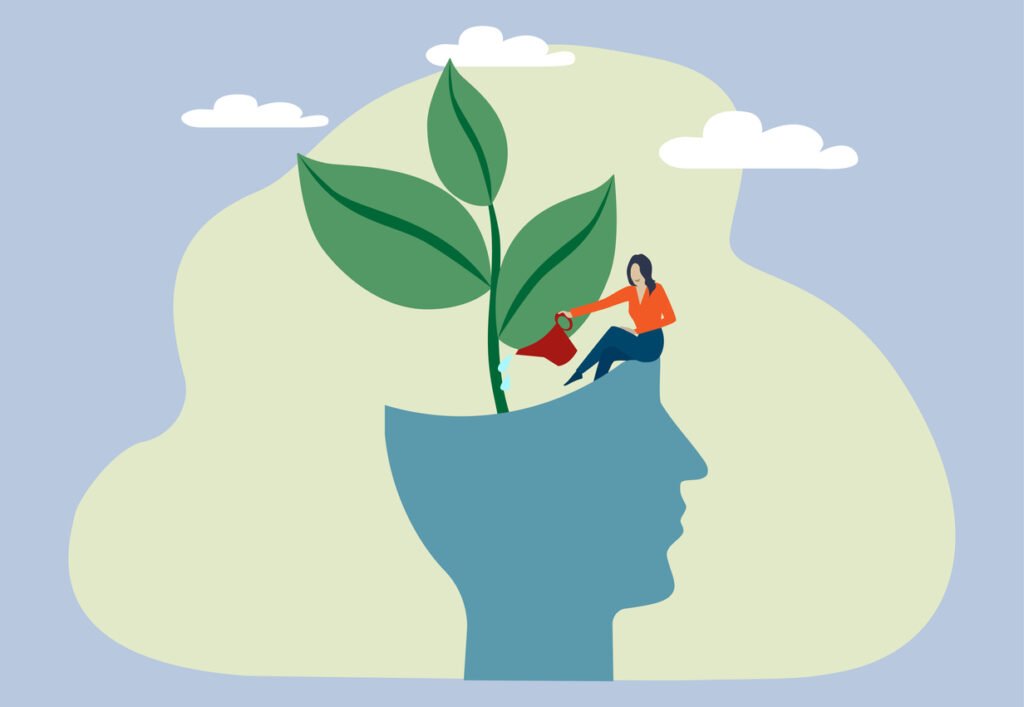
Intro
In today’s fast-paced world, prioritizing mental health is more important than ever. With increasing awareness of the significance of mental well-being, many individuals are seeking effective ways to nurture their emotional and psychological states.
Reading can be a transformative experience that not only informs but also inspires.
In this blog post, we will explore five essential books that can significantly enhance your mental health, providing insights, strategies, and comfort during challenging times.
Understanding Mental Health

Understanding mental health begins with a deep dive into the ways our experiences, particularly traumatic ones, shape our emotional and psychological well-being. One pivotal book that stands out in this regard is “The Body Keeps the Score” by Bessel van der Kolk. This insightful work delves into how trauma affects not just the mind, but also the body, offering a holistic perspective on mental health.
Van der Kolk leverages his extensive experience in the field of psychiatry to unravel the complex interactions between our brain, body, and experiences. He uses both scientific research and compelling personal stories to illuminate how traumatic events can lead to long-term mental health issues. The book explains that trauma isn’t just an emotional response; it leaves physical imprints on our bodies, influencing how we function daily.
Through the pages of “The Body Keeps the Score,” readers are introduced to the concept that our past experiences, especially those involving trauma, can have lingering effects that manifest in various ways, including anxiety, depression, and other mental health challenges. This realization is critical as it emphasizes the need for a comprehensive approach to mental health that acknowledges the interplay between our psychological and physical states.
What makes this book particularly impactful is its blend of academic rigor and accessible narrative. Van der Kolk presents complex scientific concepts in a manner that is both understandable and relatable. Readers will find themselves engrossed in case studies and anecdotes that illustrate the profound ways trauma can alter our brain function and, subsequently, our behavior and emotional regulation.
Furthermore, the book explores various therapeutic approaches to healing trauma, from traditional methods like talk therapy to innovative treatments such as EMDR (Eye Movement Desensitization and Reprocessing) and neurofeedback. These insights provide readers with a broader understanding of the available pathways to recovery, encouraging them to find the method that best suits their needs.
By understanding the biological underpinnings of trauma and its impact on mental health, readers can better appreciate the importance of seeking help and employing effective strategies for recovery. Van der Kolk’s work is a crucial resource for anyone looking to understand the deep-seated roots of their mental health issues and take the first steps toward healing.
This profound exploration underscores the necessity of recognizing and addressing trauma to improve overall mental well-being, equipping readers with the knowledge needed to embark on a journey of recovery and self-discovery.
Coping with Anxiety and Depression

Anxiety and depression are common mental health challenges that can significantly impact daily life, but effective strategies can help manage these conditions. “Feeling Good: The New Mood Therapy” by David D. Burns is a standout resource in this regard. Burns provides readers with practical cognitive-behavioral techniques designed to combat negative thought patterns and enhance emotional well-being. His approach focuses on the concept of cognitive distortions—irrational thoughts that can lead to emotional distress. By identifying and challenging these distortions, individuals can shift their mindset and improve their mood.
One of the key strengths of “Feeling Good” is its accessibility. Burns writes in a clear and straightforward manner, making complex psychological concepts easy to understand and apply. The book includes numerous exercises and examples that guide readers through the process of recognizing and addressing their own cognitive distortions. For instance, Burns introduces the idea of “thought records,” a tool that helps individuals document their negative thoughts and systematically challenge them with evidence-based counterarguments. This process can lead to a more balanced and realistic perspective, reducing feelings of hopelessness and anxiety.
Moreover, “Feeling Good” emphasizes the importance of self-monitoring and self-reflection. Burns encourages readers to become more aware of their thought patterns and emotional responses, fostering a greater sense of control over their mental state. This proactive approach empowers individuals to take an active role in their mental health journey, providing them with the tools needed to manage their symptoms effectively.
Burns also addresses the role of behavioral activation—engaging in activities that are likely to bring pleasure or a sense of accomplishment. This technique is particularly useful for individuals experiencing depression, as it can help break the cycle of inactivity and negative thinking. By gradually increasing engagement in enjoyable or meaningful activities, individuals can improve their mood and overall sense of well-being.
The book also explores the relationship between thoughts, emotions, and behaviors, underscoring the interconnectedness of these elements in mental health. Burns provides strategies for altering unhelpful behavior patterns, which in turn can positively influence emotional states. This holistic approach ensures that readers gain a comprehensive understanding of how to tackle anxiety and depression from multiple angles.
In essence, “Feeling Good” serves as a valuable guide for those looking to better understand and manage their mental health. By applying the cognitive-behavioral techniques outlined in the book, readers can develop healthier thought patterns, engage in positive behaviors, and ultimately improve their emotional well-being.
Building Resilience and Emotional Strength

Resilience is a crucial aspect of mental health, and “The Gifts of Imperfection” by Brené Brown is a must-read for those seeking to cultivate emotional strength. Brown’s work encourages readers to embrace their imperfections and recognize that vulnerability is a path to courage and connection. In this book, she outlines ten guideposts for living a wholehearted life, emphasizing the importance of self-compassion and authenticity. By engaging with her insights, readers can learn how to develop resilience, fostering a healthier relationship with themselves and navigating life’s challenges more effectively.
Brown’s guideposts include concepts such as cultivating gratitude, letting go of comparison, and embracing creativity. Each guidepost is designed to help individuals break free from societal pressures and internalized expectations that often contribute to stress and anxiety. By adopting these principles, readers can build a foundation of emotional strength that allows them to bounce back from setbacks and face adversity with a more positive outlook.
One of the standout elements of “The Gifts of Imperfection” is Brown’s emphasis on the power of vulnerability. Rather than viewing vulnerability as a weakness, Brown reframes it as a source of strength that fosters deeper connections and personal growth. This perspective can be incredibly liberating for those who struggle with feelings of shame or inadequacy, as it opens the door to self-acceptance and genuine self-expression.
The book also highlights the importance of self-compassion in building resilience. Brown argues that treating oneself with kindness and understanding, especially during times of failure or difficulty, is essential for emotional well-being. This approach contrasts sharply with the harsh self-criticism that many people default to, offering a more nurturing and supportive way to handle life’s challenges.
Additionally, “The Gifts of Imperfection” encourages readers to set boundaries and prioritize self-care. Brown emphasizes that saying no and taking time for oneself are not acts of selfishness but necessary steps for maintaining mental health. This message is particularly relevant in today’s fast-paced, achievement-oriented society, where burnout and overwhelm are common.
By exploring these guideposts, readers are equipped with practical strategies for fostering resilience. The book’s blend of personal anecdotes, research findings, and actionable advice makes it a relatable and empowering read. Brown’s warm and engaging writing style further enhances the experience, making complex psychological concepts accessible and enjoyable to explore.
Mindfulness and Meditation

In our fast-paced lives, finding moments of tranquility and presence can be challenging yet profoundly rewarding for mental health. “The Miracle of Mindfulness” by Thich Nhat Hanh offers an approachable introduction to the practices of mindfulness and meditation, making these ancient techniques accessible to contemporary readers. Hanh’s writing is infused with a sense of peace and wisdom, providing readers with the tools to cultivate mindfulness in their daily lives.
The book is structured around simple exercises and reflective anecdotes that illustrate the power of being fully present. Hanh encourages readers to engage in mindfulness during everyday activities, such as washing dishes, eating, or walking. By paying close attention to these mundane tasks, individuals can develop a deeper sense of awareness and connection to the present moment. This practice can help reduce stress, anxiety, and the tendency to ruminate on the past or worry about the future.
One of the key teachings in “The Miracle of Mindfulness” is the concept of “mindful breathing.” Hanh explains how conscious breathing can anchor us in the present moment, providing a sense of calm and stability. This technique is both simple and effective, making it a practical tool for anyone seeking to manage their mental health. The act of focusing on the breath allows individuals to create a space of peace within themselves, even amidst external chaos.
Hanh also introduces the idea of “walking meditation,” where each step is taken with full awareness and presence. This practice transforms a routine activity into an opportunity for mindfulness, helping individuals to slow down and appreciate the world around them. Walking meditation can be particularly beneficial for those who find sitting meditation challenging, offering an alternative way to engage in mindfulness.
Throughout the book, Hanh emphasizes the importance of self-compassion and gentle perseverance. He acknowledges that developing mindfulness is a gradual process and encourages readers to be patient with themselves. This nurturing approach can be especially helpful for those who are new to meditation or who struggle with maintaining a consistent practice.
“The Miracle of Mindfulness” also explores the interconnectedness of mindfulness and compassion. Hanh suggests that by being fully present and aware, individuals can cultivate a deeper sense of empathy and kindness towards themselves and others. This shift in perspective can lead to more harmonious relationships and a greater sense of community.
In essence, Thich Nhat Hanh’s “The Miracle of Mindfulness” provides a comprehensive yet gentle guide to incorporating mindfulness into everyday life. Through its practical exercises and profound insights, the book helps readers to find peace and balance, enhancing their overall mental health.
Supporting Loved Ones with Mental Health Challenges

When supporting friends or family members facing mental health challenges, having a deep understanding and a compassionate approach is key. “The Noonday Demon: An Atlas of Depression” by Andrew Solomon provides an invaluable perspective on the multifaceted nature of depression. Solomon intertwines his personal battle with depression alongside extensive research and interviews, offering a comprehensive view of the condition.
The book illuminates the varied manifestations of depression, from the subtle to the severe, and the profound impact it has on every aspect of a person’s life. By reading Solomon’s account, supporters can gain a clearer understanding of what their loved ones might be experiencing, from the internal struggles to the external repercussions. This knowledge can foster empathy, helping supporters to approach their loved ones with sensitivity and patience.
One of the standout elements of “The Noonday Demon” is its exploration of the social stigma surrounding mental illness. Solomon discusses the societal pressures and misconceptions that often exacerbate the challenges faced by those with depression. This insight is crucial for supporters to recognize the additional layer of difficulty that stigma brings and to actively work against it in their interactions and advocacy.
The book also provides practical advice on how to support someone with depression. Solomon emphasizes the importance of listening without judgment, offering consistent emotional support, and encouraging professional help when necessary. Understanding that depression is not a condition that can be willed away or fixed with simple solutions is vital for supporters. Instead, providing a stable, non-judgmental presence can make a significant difference.
Additionally, Solomon’s work highlights the importance of self-care for supporters. Supporting someone with depression can be emotionally taxing, and maintaining one’s own mental health is essential to providing effective support. Solomon’s balanced approach encourages supporters to seek their own sources of support, whether through counseling, support groups, or other means.
In essence, “The Noonday Demon” serves as a crucial resource for anyone looking to support a loved one through depression. By combining personal narrative with broader research, the book offers a profound and practical guide to understanding and compassionately supporting those facing mental health challenges.
